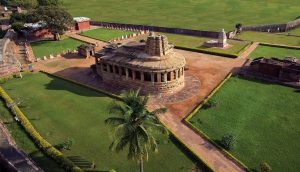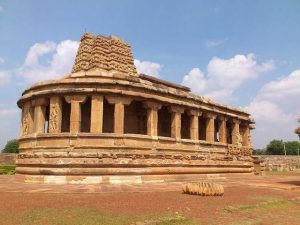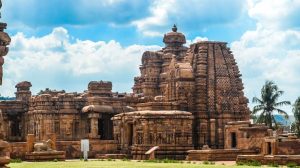Digital News Guru Karnataka Desk:
Aihole: The Ancient Temple Town of Karnataka
Nestled in the state of Karnataka, Aihole is a small village with immense historical and cultural significance. Often referred to as the “Cradle of Indian Architecture,” Aihole is known for its ancient temples, intricate rock-cut architecture, and its central role in the development of Hindu temple architecture during the 6th to 8th centuries. It is located in the Bagalkot district, near the banks of the Malaprabha River, about 35 kilometers from the modern-day city of Badami. This tranquil village holds the key to understanding the evolution of Indian temple architecture, especially the early development of the Chalukyan dynasty.
Historical Significance of Aihole
Aihole was once the capital of the Chalukya dynasty in the 6th century and played a pivotal role in shaping the art, architecture, and religious practices in the Deccan region. The village’s rich cultural history is reflected in its collection of over 125 temples, most of which are dedicated to various Hindu deities such as Shiva, Vishnu, and Durga.

Aihole’s most significant historical contribution lies in the fact that it was a hub for architectural experimentation during the Chalukya dynasty’s reign. Under the leadership of King Pulakeshin II, the Chalukyas promoted the development of a distinctive architectural style known as the “Chalukyan Style,” which laid the foundation for many of the temples built across southern India during subsequent centuries.
In addition to its importance in temple architecture, Aihole is mentioned in various ancient texts, including the accounts of travelers such as Xuanzang, the Chinese Buddhist monk. His visit to Aihole during the 7th century provides valuable insights into the town’s religious and cultural prominence during the medieval period.
Architectural Marvels of Aihole
The temples in Aihole are a fine example of the rich architectural heritage of the Chalukyan dynasty. The most notable feature of these temples is the evolution of the Dravidian architectural style, which saw the transition from early experimental forms to more refined and sophisticated temple structures.
- Durga Temple: This temple is one of the most iconic in Aihole and features a unique apsidal (curved) shape, which is believed to be one of the earliest examples of such a design in India. It is dedicated to Goddess Durga, and its architecture is an excellent representation of the early experimentation in temple architecture by the Chalukyas.
- Ravalphadi Cave Temple: A rock-cut temple carved into a cliff face, this temple is known for its intricately carved sculptures of deities. The temple’s layout represents the early form of the Dravidian style, marking the transition from simple stone structures to more complex, ornate designs.
- Bhagavati Temple: Known for its splendid stone carvings, the Bhagavati Temple is one of the many temples in Aihole that highlights the influence of the Jain and Buddhist architectural styles on Hindu temple construction. The temple’s inscriptions provide crucial information regarding the local culture and politics of the period.
- Meguti Temple: Another important structure in Aihole, the Meguti Temple stands atop a hill, offering spectacular views of the surrounding landscape. It is dedicated to Lord Shiva and is renowned for its unique architecture, which blends elements of both North and South Indian architectural styles.
- Huchimalli Temple: The Huchimalli Temple is one of the earliest temples constructed under the Chalukyan dynasty. The temple is dedicated to Lord Shiva and is built using sandstone. The temple’s simple but effective design marks the beginning of the Chalukyan architectural evolution.
- Lad Khan Temple: Another fascinating structure in Aihole is the Lad Khan Temple, which is one of the earliest examples of the Hindu temple architecture associated with the Chalukyas. This temple is said to have originally been a Jain shrine before being converted into a Hindu temple, showcasing the religious tolerance that was prevalent during the period.

These temples, along with many others scattered across the village, reflect the Chalukyan mastery in the art of building temples and their attempt to harmonize various regional styles into one cohesive form.
The Evolution of Temple Architecture in Aihole
Aihole is renowned for being a testing ground for the evolution of Indian temple architecture. The variety of styles seen in the temples of Aihole shows a gradual transition from simple, flat-roofed structures to the more intricate and grandiose temples that later became characteristic of the Chalukyan dynasty.
The early temples, such as the Lad Khan Temple, display a blend of local architectural styles with the introduction of Dravidian features. Later temples, such as the Durga Temple, demonstrate more developed forms of Hindu temple architecture, with large mandapas (pillared halls) and elaborate carvings.
The influence of Aihole’s architecture spread to other regions of Karnataka and even to neighboring states. Temples in places like Badami, Pattadakal, and even further south in Tamil Nadu, display architectural characteristics that can be traced back to Aihole. It is often considered the birthplace of temple architecture in South India, marking the early development of the South Indian style that would later flourish during the Chola and Vijayanagara empires.
Aihole’s Role in the Development of Indian Art and Culture
Aihole’s temples are not just architectural marvels; they also represent the rich cultural and artistic traditions of the Chalukyas. The intricate sculptures that adorn the temples depict various Hindu deities, mythological stories, and daily life during the time of the Chalukyas. These carvings are not only religious in nature but also provide valuable insights into the social, economic, and political life of the period.
Aihole also played a significant role in the development of religious and cultural practices in India. The coexistence of Jainism, Buddhism, and Hinduism in the region is evident in the temple architecture, reflecting the pluralistic nature of Indian society during the early medieval period. This is particularly visible in the blend of Jain and Hindu elements in some of the temples, symbolizing a period of religious harmony and tolerance.
Aihole Today
Today, Aihole remains a small rural village, but it attracts scholars, historians, and tourists from all over the world. The site is a UNESCO World Heritage Site candidate and continues to be an important destination for those interested in India’s architectural heritage.

The Archaeological Survey of India has undertaken efforts to preserve the site, ensuring that the ancient temples remain protected for future generations. Additionally, the annual Aihole Utsav festival celebrates the rich cultural heritage of the region, featuring music, dance, and other traditional performances.
Conclusion
Aihole, with its ancient temples and profound architectural history, stands as a testament to the creativity and ingenuity of the Chalukyan dynasty. It remains an important cultural and historical landmark, not only for Karnataka but for all of India. Visitors to Aihole are not just exploring a village; they are stepping into a living museum of architectural and artistic evolution, witnessing the beginnings of South Indian temple architecture that would come to define an entire region for centuries to come.
You May Also Read: IND vs AUS, 4th Test: Kohli-Konstas confrontation








